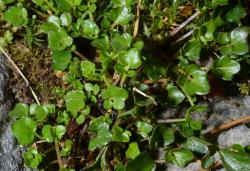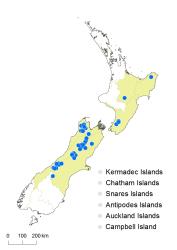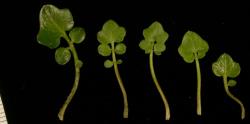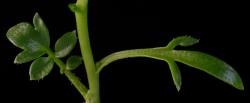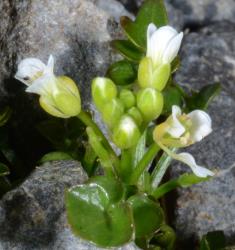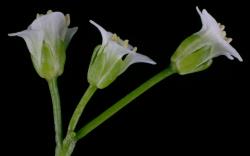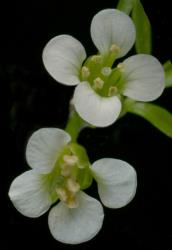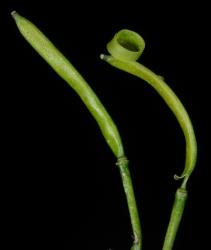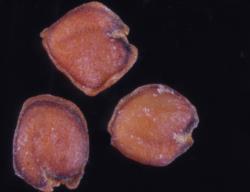Perennial herb, single rosette or multiple rosettes on short lateral branches, rhizomatous. Leaves up to 100 mm long, simple or pinnatisect; lamina 5.0–36.0 × 6.0–16.0 mm, green to grey-green, often flushed purple, coriaceous, glabrous on abaxial surface, glabrous to sparsely hairy on adaxial surface, margin and petiole, glossy; hairs 0.4–0.5 mm long, spreading to patent; petiole up to 80 mm long, sparsely to moderately hairy or occasionally glabrous. Terminal pinna 3.0–13.0 × 4.0–17.0 mm, simple to slightly 3-lobed, broadly orbicular, broadly reniform; orbicular-deltoid to orbicular-rhomboid; margin entire or with 2 lateral triangular lobes, 2(–4) distinct hydathodes; apex obtuse with a distinct hydathode; base cordate, truncate or occasionally obtuse. Lateral pinnae 2–6 or absent, 1.3–9.0 × 0.7–10.0, simple to sometimes slightly 2-lobed, orbicular to broadly elliptic-orbicular; margin with 0(–2) distinct hydathodes; apex obtuse with a distinct hydathode; base obtuse, often oblique; sessile or petiolule up to 2.5(–8.0) mm long. Cauline leaves similar to rosette leaves but smaller and narrower, with fewer lateral pinnae, pinnae bases attenuate to cuneate; terminal pinna up to 18.0 × 5.4 mm; lateral pinnae up to 4.2 × 2.6 mm. Inflorescence racemose to cymose-racemose, each 1–12-flowered; peduncle up to 120 mm long, 0.5–2.0 mm diam. at base, spreading to ascending, glabrous. Pedicels 6.0–9.0 mm long, 0.2–0.7 mm diam., glabrous. Sepals 1.8–3.2 × 0.8–1.4 mm, elliptic-oblong, saccate, green to red-brown, glabrous, margin white and membranous, apex obtuse, base truncate. Petals 2.6–7.5 × 0.8–3.8 mm, white, limb obovate; apex obtuse; base attenuate to obtuse, tapering to a 1.0–2.5 mm long claw. Stamens 6; median filaments (3–)4, 1.9–4.0 mm long; lateral filaments 2, 1.7–3.2 mm long; anthers 0.4–0.8 mm long, cream to pale yellow, when dehiscent held at a similar height to or slightly below the stigma. Ovary 2.2–4.3 mm long, 0.4–0.7 mm diam., ± terete, green to reddish green, glabrous; ovules 20–28; style 0.2–0.4 mm long, ± terete; stigma 0.4–0.5 mm diam. Siliques 9.0–38.0 × 1.1–1.9 mm, glabrous, style 0.8–2.6 mm long; valves green, purple-green to purple-brown at maturity and when dehiscent; replum 0.3–0.5 mm wide. Seeds 0.9–1.5 mm long, 0.8–1.1 mm wide, 0.3–0.5 mm thick, orbicular, oblong to broadly oblong, henna; wing present at apex and lateral margin, <0.1 mm wide.
North Island: Gisborne, Volcanic Plateau, Southern North Island.
South Island: Western Nelson, Sounds Nelson, Marlborough, Canterbury, Westland.
Cardamine alalata occurs on ledges and crevices of alpine rock bluffs, but has also been collected from river gravels, rocky ground, cliffs, scree, damp seepages, and herbfield. It is known from a single lower altitude (600 m) stony site in the Karangarua Valley, Westland.
Cardamine alalata is assessed as having a conservation status of Not Threatened (de Lange et al. 2018).
Flowering December–March; Fruiting December–March.
Specimens referable to C. alalata were included in Cardamine "Scree Race" by Druce (1993), although Pritchard (1957) specifically mentioned in his description that the plants he referred to C. "Scree Race" had inconspicuous leaf hydathodes; the hydathodes of C. alatata are conspicuous. This species was also previously referred to as C. "high altitude glossy green" (Wilson 1976), C. "high altitude" (Wilson 1978), and C. "aff. uniflora Mt Cook" (P. Wardle, specimens in Allan Herbarium, CHR).



